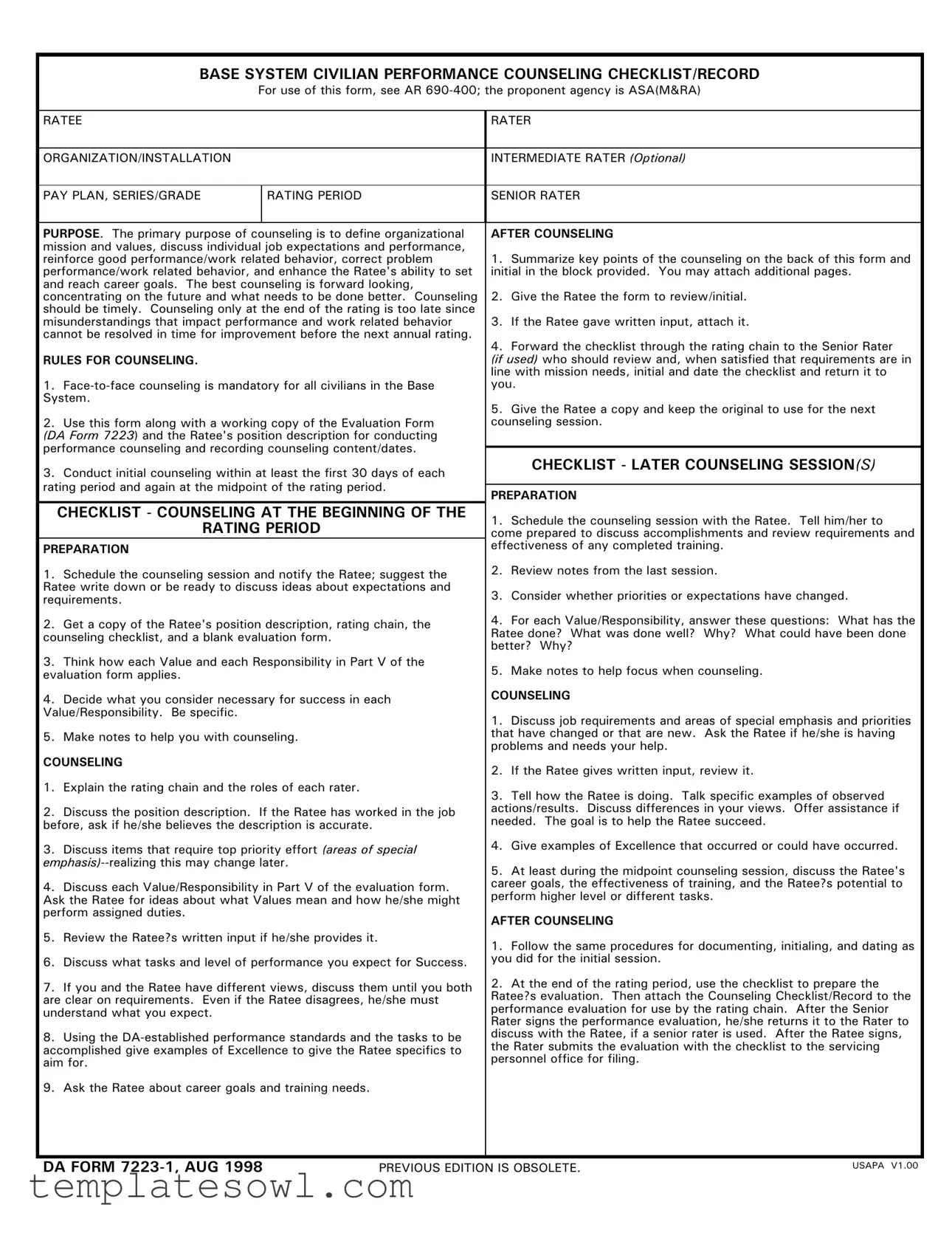|
RATEE |
|
RATER |
|
|
|
|
|
ORGANIZATION/INSTALLATION |
|
INTERMEDIATE RATER (Optional) |
|
|
|
|
|
PAY PLAN, SERIES/GRADE |
RATING PERIOD |
SENIOR RATER |
|
|
|
|
|
PURPOSE. The primary purpose of counseling is to define organizational |
AFTER COUNSELING |
|
mission and values, discuss individual job expectations and performance, |
|
|
|
reinforce good performance/work related behavior, correct problem |
1. |
Summarize key points of the counseling on the back of this form and |
|
performance/work related behavior, and enhance the Ratee's ability to set |
initial in the block provided. You may attach additional pages. |
|
and reach career goals. The best counseling is forward looking, |
|
|
|
concentrating on the future and what needs to be done better. Counseling |
2. |
Give the Ratee the form to review/initial. |
|
should be timely. Counseling only at the end of the rating is too late since |
|
|
|
misunderstandings that impact performance and work related behavior |
3. |
If the Ratee gave written input, attach it. |
|
cannot be resolved in time for improvement before the next annual rating. |
|
|
|
|
|
4. Forward the checklist through the rating chain to the Senior Rater |
|
RULES FOR COUNSELING. |
|
(if used) who should review and, when satisfied that requirements are in |
|
|
|
line with mission needs, initial and date the checklist and return it to |
|
1. Face-to-face counseling is mandatory for all civilians in the Base |
you. |
|
System. |
|
5. Give the Ratee a copy and keep the original to use for the next |
|
|
|
|
2. Use this form along with a working copy of the Evaluation Form |
counseling session. |
|
(DA Form 7223) and the Ratee's position description for conducting |
|
|
|
performance counseling and recording counseling content/dates. |
|
|
|
|
CHECKLIST - LATER COUNSELING SESSION(S) |
|
3. Conduct initial counseling within at least the first 30 days of each |
|
|
|
|
|
rating period and again at the midpoint of the rating period. |
|
|
|
PREPARATION |
|
|
|
|
CHECKLIST - COUNSELING AT THE BEGINNING OF THE |
1. Schedule the counseling session with the Ratee. Tell him/her to |
|
RATING PERIOD |
|
come prepared to discuss accomplishments and review requirements and |
|
|
|
|
PREPARATION |
|
effectiveness of any completed training. |
|
|
|
|
|
1. Schedule the counseling session and notify the Ratee; suggest the |
2. Review notes from the last session. |
|
|
|
|
Ratee write down or be ready to discuss ideas about expectations and |
3. Consider whether priorities or expectations have changed. |
|
requirements. |
|
|
|
|
|
|
2. Get a copy of the Ratee's position description, rating chain, the |
4. For each Value/Responsibility, answer these questions: What has the |
|
Ratee done? What was done well? Why? What could have been done |
|
counseling checklist, and a blank evaluation form. |
|
better? Why? |
|
|
|
|
3. Think how each Value and each Responsibility in Part V of the |
5. Make notes to help focus when counseling. |
|
evaluation form applies. |
|
|
|
|
|
|
4. Decide what you consider necessary for success in each |
COUNSELING |
|
|
|
|
Value/Responsibility. Be specific. |
|
1. Discuss job requirements and areas of special emphasis and priorities |
|
|
|
|
5. Make notes to help you with counseling. |
that have changed or that are new. Ask the Ratee if he/she is having |
|
problems and needs your help. |
|
|
|
|
COUNSELING |
|
2. If the Ratee gives written input, review it. |
|
|
|
|
1. Explain the rating chain and the roles of each rater. |
3. Tell how the Ratee is doing. Talk specific examples of observed |
|
|
|
|
2. Discuss the position description. If the Ratee has worked in the job |
actions/results. Discuss differences in your views. Offer assistance if |
|
needed. The goal is to help the Ratee succeed. |
|
before, ask if he/she believes the description is accurate. |
|
|
|
|
3. Discuss items that require top priority effort (areas of special |
4. Give examples of Excellence that occurred or could have occurred. |
|
|
|
|
emphasis)--realizing this may change later. |
5. At least during the midpoint counseling session, discuss the Ratee's |
|
|
|
|
4. Discuss each Value/Responsibility in Part V of the evaluation form. |
career goals, the effectiveness of training, and the Ratee?s potential to |
|
perform higher level or different tasks. |
|
Ask the Ratee for ideas about what Values mean and how he/she might |
|
|
|
|
perform assigned duties. |
|
AFTER COUNSELING |
|
|
|
|
5. Review the Ratee?s written input if he/she provides it. |
1. Follow the same procedures for documenting, initialing, and dating as |
|
|
|
|
6. Discuss what tasks and level of performance you expect for Success. |
you did for the initial session. |
|
|
|
|
7. If you and the Ratee have different views, discuss them until you both |
2. At the end of the rating period, use the checklist to prepare the |
|
Ratee?s evaluation. Then attach the Counseling Checklist/Record to the |
|
are clear on requirements. Even if the Ratee disagrees, he/she must |
|
performance evaluation for use by the rating chain. After the Senior |
|
understand what you expect. |
|
|
|
Rater signs the performance evaluation, he/she returns it to the Rater to |
|
|
|
|
8. Using the DA-established performance standards and the tasks to be |
discuss with the Ratee, if a senior rater is used. After the Ratee signs, |
|
the Rater submits the evaluation with the checklist to the servicing |
|
accomplished give examples of Excellence to give the Ratee specifics to |
|
personnel office for filing. |
|
aim for. |
|
|
|
|
|
9. Ask the Ratee about career goals and training needs.


